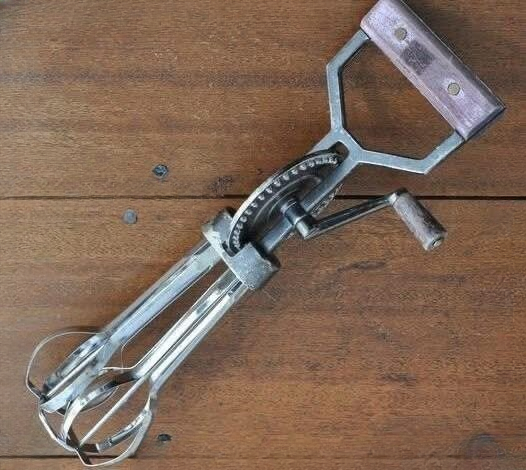Every kitchen holds stories — quiet revolutions that changed the way we eat, live, and connect. We take them for granted now: the hum of a refrigerator, the gleam of a toaster, the steady whir of a mixer. Yet behind each of these tools lies a chain of ingenuity, struggle, and serendipity.
Take the humble mixer. That workhorse of baking and Sunday dinners didn’t start as the sleek, multi-speed machine on your counter. It began as a strange, crank-driven contraption, all gears and elbow grease. Its story is a reminder that necessity, frustration, and creativity often walk hand in hand.
A Curious Object That Stumped the Internet
Not long ago, a photo surfaced online of a peculiar, rusted metal device — a hand crank with two intertwined whisks. The internet buzzed. Was it a farm tool? A medical device? A forgotten gadget?
It turned out to be one of the earliest mechanical egg beaters, an ancestor of today’s electric mixer. In a world of instant gratification, the physicality of it — the turning gears, the rhythmic motion — felt almost poetic. People marveled at the effort once required to do something as simple as mixing batter. And that story stretches back nearly two centuries.
The 19th-Century Kitchen Revolution
Before the 1800s, mixing anything — bread dough, cake batter, you name it — meant hours of hand labor. Wooden spoons, wire whisks, aching arms.
Then, in 1856, Ralph Collier patented the first hand-cranked egg beater. Gear-driven, simple, and brilliant, it could rotate two beaters in seconds, turning ten minutes of furious whisking into a breeze. Soon, dozens of inventors filed patents, and brands like Dover and Enterprise became household names.
Early beaters were built from cast iron and brass, over-engineered yet elegant. Generations polished their handles with use, each Sunday morning breakfast or Christmas cake leaving its mark.
Enter Electricity
The next leap came with the electric age. In 1910, Herbert Johnston, an engineer at Hobart Manufacturing, saw a baker struggling with dough and thought, “There has to be a better way.”
By 1919, Hobart released the first electric stand mixer for home use: the KitchenAid H-5. Seventy pounds, the price of a month’s rent, yet it transformed kitchens. For the first time, home cooks could prepare large batches effortlessly, letting the machine do the heavy lifting. Today’s mixers still rely on that same blueprint: a motor, a bowl, and interchangeable beaters.
The Mixer as Cultural Icon
By the 1950s, mixers became symbols of progress and domestic creativity. Bright colors, gleaming chrome, television ads promising “more time for the things that matter” — owning a mixer was more than convenience; it was modern life on display.
Through changing gender roles and cultural shifts, the mixer endured, reliable and almost indestructible.
When the Internet Rediscovers the Past
That viral photo of the old hand-cranked beater resonated deeply. It wasn’t just curiosity; it was nostalgia, a connection to a slower, more tactile world. A commenter remembered, “My grandmother had one of these. The soft whir of the gears, the clink of the bowl — I can still hear it every Sunday morning.”
The Science of Simplicity
Engineers still admire the efficiency of the original design. Twin beaters for even aeration, a crank that transforms small effort into powerful motion. Modern mixers refine the same physics. Innovation, often, is not reinvention — it’s mastery.
From Utility to Legacy
Today, antique mixers are collector’s items, heirlooms, conversation pieces. Using a hand-cranked model now can be meditative — a tactile rebellion against automated kitchens, a reminder of the joy in making something by hand.
Why It Still Matters
Every kitchen tool carries invisible fingerprints: the inventors, the users, the lives quietly changed. The mixer’s history is a story of liberation — from hand fatigue, from wasted time, from necessity. It turned labor into creation and baking into joy.
Even the simplest egg beater can stop an internet scroll and make us pause, remembering that progress isn’t always the newest gadget. Sometimes it’s the enduring simplicity of the things we’ve already mastered.
So next time your mixer hums softly on the counter, remember: beneath that hum lies 150 years of ingenuity, craft, and imagination. The quiet magic of the mixer reminds us that true revolution often hides in the ordinary.
